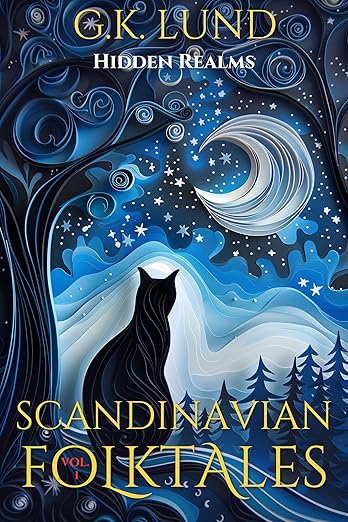
Once, the Lord wanted to test if all people could agree on something, like wishing for rainy weather. For three years, there was no rain on Earth, causing great distress. He thought that now everyone was in agreement to wish for rain, and it came. But on the same day, a woman had hung her clothes out to dry, and she was not happy at all. “That’s typical,” she complained. “If it’s been dry for three years, it certainly could have lasted one more day.”
I’ve long had a minor interest in folk beliefs and superstitions, for incorporating in my stories if for no other reason. The folk beliefs of Scandinavia interest me most, of course, but if you read accounts from further abroad, you tend to see great commonality. Everybody seems to have believed in “little people” who lived at the margins of society, and their tales of human interaction with such folk tend to exhibit very similar motifs.
G. K. Lund’s Hidden Realms: Scandinavian Folktales presents a selection of her own translations of folk stories (called sagn, which is pronounced very much like “song”). These are not fairy tales as such – as she takes pains to explain – they aren’t fully formed fantastic tales. They’re more like anecdotes. Some of them are only one or two lines long.
The greater part of the stories involve what were known as Vættir, a broad classification that includes all the Scandinavian fantastic beings. Mostly these are elves, dwarfs, trolls and what the Norwegians call nisser – like a brownie or a gnome. There is no exact taxonomy, of course; the creatures often mix and match traits and can be hard to distinguish from one another.
There are rules for dealing with them, of course, but the rules can vary from one story to another. It’s generally agreed that it’s not a good idea to follow them “into the hill” where they live, or to eat their food, but both those taboos are sometimes broken without harm. Sometimes humans can fool them and profit thereby, and at other times they pay a high price. Sometimes an act of kindness to them brings rich reward, and but at other times it can be a mistake, as when a kind farm wife sews a new suit of clothes for the “barn nisse” only to have him stop helping with the farm work because he doesn’t want to get them dirty.
Such stories fascinate me; I’ve always wanted to write a story about them that captured their alien logic. I’m not sure I’ve ever come close.
G. K. Lund’s translations in Hidden Realms are generally quite good, though I nitpicked from time to time, as one does. The book features very handsome illustrations – somewhat reminiscent of Theodor Kittelsen (see last night’s post) though a little smooth for my taste.
Very enjoyable, if you’re into this stuff.
